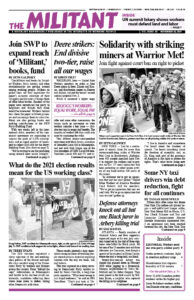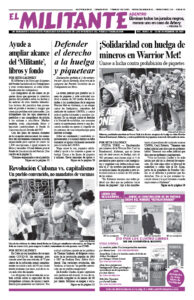Fifteen days after some two dozen New York City yellow-cab drivers began a well-publicized hunger strike, New York Mayor Bill de Blasio, U.S. Sen. Chuck Schumer and Taxi and Limousine Commissioner Aloysee Heredia Jarmoszuk announced Nov. 3 an agreement had been reached between the city, the New York Taxi Workers Alliance and Marblegate Asset Management, the largest holder of taxi driver’s loans, to begin to address the crushing debts faced by many medallion owner-drivers.
Under the agreement, the city pays $30,000 to Marblegate on each of its outstanding loans. The lender in turn reduces the amount each cab-medallion owner owes to $170,000, payable at 5% interest over 20 years. Debt-service payments covered by the agreement are to be capped at $1,122 per month. The city agrees to guarantee the loans, meaning it will pay off the debt if any cabbie defaults.
The yellow-cab drivers on hunger strike in front of City Hall broke it off when they received the news.
“I knew one of the nine drivers who died by suicide,” Augustine Tang, 37, one of those on the fast, told the Militant. “After years of the burden and pressures of uncertainty, losing homes, credit being shot, not having a decent life at retirement, it feels incredible that we won this.”
A medallion is the license sold by the city — and fixed on the hood of every yellow cab — that authorizes drivers to pick up passengers on the street. Marblegate owns what had been highly profitable loans on roughly 4,000 of the city’s 13,500 medallions.
“Medallion owners,” the ones covered by this agreement, “are only 2% of the driving workforce,” said Tang. Indeed, there are a wide variety of for-hire drivers here, from those who work for apps like Uber, to livery and black car services, to those workers who pay rent to medallion owners to drive on shifts, to green-cab drivers limited to uptown Manhattan and outer boroughs, and more. Some drivers work in two or three categories. Hours of service, car ownership and pay rates all vary widely.
The price of an average medallion began soaring in 2002, going from $200,000 to more than $1 million in 2014. The city raked in money by promoting them as an investment “better than the stock market” and selling them as prices rose, as well as collecting taxes on the sales. To buy, most purchasers took out sizable loans from credit unions and banks. In late 2014 the bubble burst and the price plummeted below $200,000. Marblegate then began buying up the loans.
Other lenders, who together carry about 60% of the outstanding loans, have yet to say whether they will accept the deal.
“We hope other lenders will join in,” Erhan Tuncel, another of the hunger strikers, said.
In March the city had set up a $65 million fund taken from federal COVID relief money where drivers could apply for up to $29,000 to restructure their loans. The plan combined $20,000 as a new, interest-free loan from the city, with $9,000 to use for monthly loan payments. Víctor Salazar, a driver who lost his medallion, called the March fund “a band-aid for a bullet wound.”
It isn’t clear whether drivers who took the March offer will be eligible for the new program.
Eric Oppong drives a cab, but leases it from the medallion owner. He recalled seeing protests by medallion owners decrying predatory pricing and lending practices “a couple years ago, and I said to myself, ‘I am with them. I’m not one of them, but I can put myself in their shoes.’ I hope they got some relief.”
There are 159,000 drivers currently licensed by the city’s Taxi and Limousine Commission, though many stopped driving during government pandemic lockdowns and plummeting tourism. Many are not yet back on the streets working.
Despite the different circumstances facing the wide variety of for-hire drivers, they share one thing in common: they work for wages to pay off their lease and their loans — for the day, week, month lease, or vehicle and medallion loans — and only then see what they have left for income. All must pay fees and tickets, get licensed by the city, buy gas, maintain their vehicles, and compete for fares in an industry that is adding drivers by the day as business begins to rebound.

